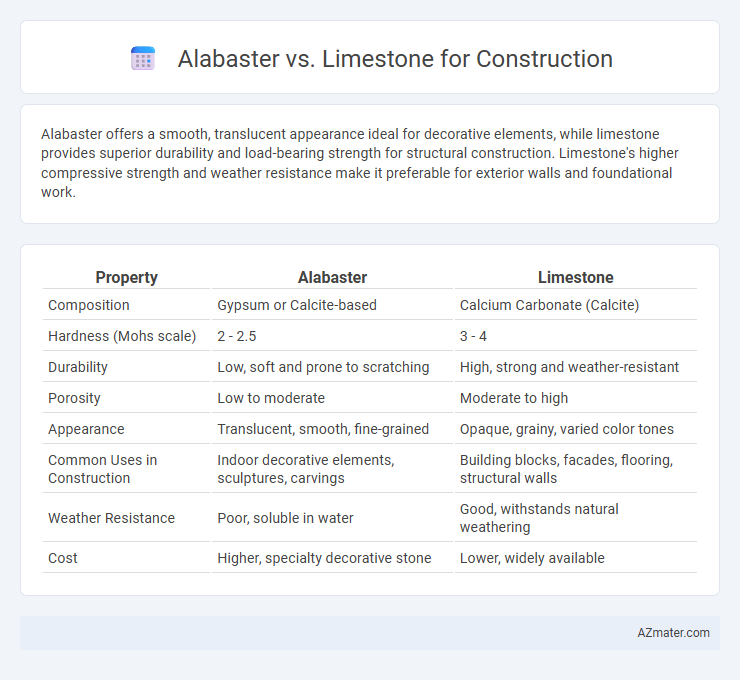Alabaster offers a smooth, translucent appearance ideal for decorative elements, while limestone provides superior durability and load-bearing strength for structural construction. Limestone's higher compressive strength and weather resistance make it preferable for exterior walls and foundational work.
Table of Comparison
| Property | Alabaster | Limestone |
|---|---|---|
| Composition | Gypsum or Calcite-based | Calcium Carbonate (Calcite) |
| Hardness (Mohs scale) | 2 - 2.5 | 3 - 4 |
| Durability | Low, soft and prone to scratching | High, strong and weather-resistant |
| Porosity | Low to moderate | Moderate to high |
| Appearance | Translucent, smooth, fine-grained | Opaque, grainy, varied color tones |
| Common Uses in Construction | Indoor decorative elements, sculptures, carvings | Building blocks, facades, flooring, structural walls |
| Weather Resistance | Poor, soluble in water | Good, withstands natural weathering |
| Cost | Higher, specialty decorative stone | Lower, widely available |
Introduction to Alabaster and Limestone
Alabaster, a fine-grained form of gypsum or calcite, is prized in construction for its smooth texture and translucency, making it popular for decorative elements and interior applications. Limestone, a sedimentary rock primarily composed of calcium carbonate, offers durability and versatility, commonly utilized in structural components, facades, and flooring. The contrasting physical properties of alabaster and limestone influence their specific uses in architectural design and construction projects.
Geological Origins and Composition
Alabaster, primarily composed of gypsum (calcium sulfate dihydrate), forms through the evaporation of ancient seawater in sedimentary basins, resulting in a fine-grained, translucent stone ideal for detailed carving. Limestone consists mainly of calcite (calcium carbonate), originating from the accumulation and compaction of marine organism shells and skeletal fragments in shallow, warm marine environments. The distinct mineral compositions influence their durability and workability, with alabaster being softer and more susceptible to moisture compared to the harder, more weather-resistant limestone.
Physical Appearance and Texture
Alabaster features a smooth, translucent texture with a fine grain that allows light to pass through, creating a soft glow ideal for decorative applications. Limestone has a more granular, porous surface with varied textures ranging from fine to coarse, often showcasing natural fossil patterns and earth-toned hues suitable for structural and facade uses. The polished finish of alabaster contrasts with the matte or honed finish typical of limestone, influencing their distinct visual appeal in construction projects.
Strength and Durability Comparison
Alabaster is a softer, more delicate stone primarily used for decorative elements rather than structural support, with a Mohs hardness of about 2, making it vulnerable to scratches and weathering. Limestone offers significantly greater strength and durability, typically scoring between 3 and 4 on the Mohs scale, and demonstrates excellent resistance to compression, making it ideal for load-bearing construction and exterior applications. In terms of longevity, limestone withstands environmental stresses better than alabaster, ensuring superior performance in both residential and commercial building projects.
Suitability for Indoor and Outdoor Construction
Alabaster offers excellent suitability for indoor construction due to its soft, translucent properties and ease of carving, making it ideal for decorative elements, sculptures, and interior wall cladding. Limestone, with its greater durability and resistance to weathering, is more suitable for outdoor construction, commonly used in facades, paving, and structural components exposed to environmental elements. Both stones require proper sealing, but limestone's hardness and porosity make it the preferred choice for exterior architectural projects, while alabaster remains favored indoors for aesthetic appeal and fine detailing.
Workability and Ease of Installation
Alabaster offers superior workability due to its fine grain and softness, making it easier to carve and shape precisely compared to limestone. Limestone, while generally harder and more durable, requires more effort and specialized tools during installation, potentially increasing labor time and costs. Choosing alabaster can streamline complex artistic features, whereas limestone is preferred for structural applications demanding greater strength.
Cost and Availability
Alabaster is generally more expensive than limestone due to its rarity and delicate nature, making it less commonly used in large-scale construction projects. Limestone, abundant worldwide and available in various grades, offers a cost-effective and widely accessible option for building materials. The widespread availability of limestone ensures lower transportation costs and greater affordability compared to the more limited supply of alabaster.
Maintenance Requirements
Alabaster requires more delicate maintenance compared to limestone due to its softness and higher susceptibility to scratching and etching from acids. Limestone, being harder and more durable, demands less frequent sealing and is generally easier to clean, making it suitable for high-traffic or exterior construction applications. Both materials benefit from periodic sealing and gentle cleaning methods to preserve their appearance and structural integrity over time.
Environmental Impact and Sustainability
Alabaster, a softer and less durable material compared to limestone, typically requires less energy-intensive processing, resulting in a lower carbon footprint during extraction and fabrication. Limestone, widely used in construction for its strength and durability, often involves higher energy consumption for quarrying and processing but offers longer-lasting structural benefits that contribute to sustainability through reduced maintenance and replacement needs. Both materials' environmental impacts depend heavily on local quarrying practices, transportation emissions, and the ability to recycle or repurpose waste during construction projects.
Choosing the Right Stone for Your Project
Selecting between alabaster and limestone for construction hinges on factors like durability, appearance, and application requirements. Alabaster, a softer, translucent stone valued for intricate carvings and decorative elements, is less durable and suitable for interior use. Limestone, a dense, robust sedimentary rock, offers superior strength and weather resistance, making it ideal for structural components and exterior projects.

Infographic: Alabaster vs Limestone for Construction
 azmater.com
azmater.com